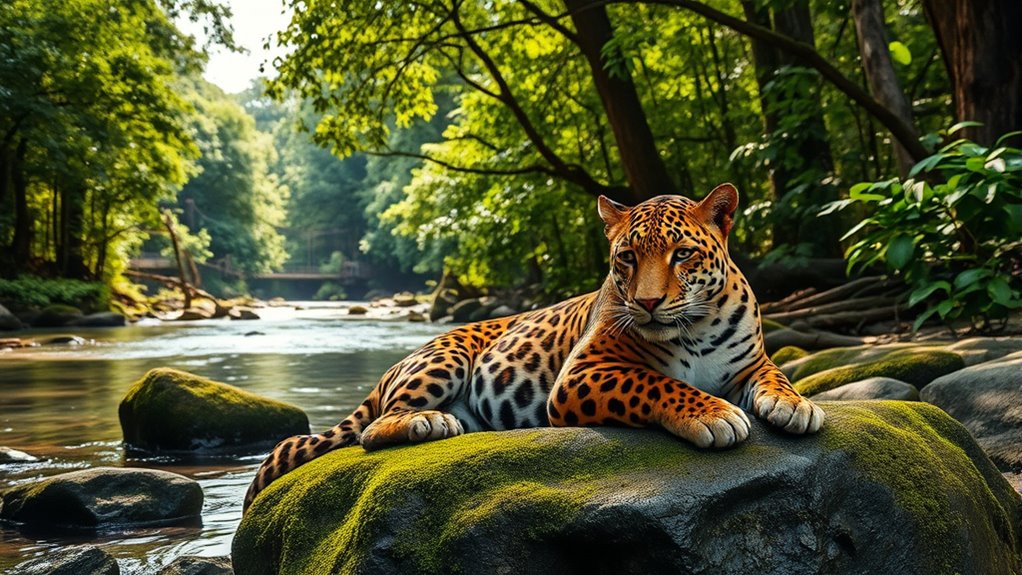Protecting endangered species involves laws and treaties that set strict rules against habitat destruction, illegal hunting, and trafficking. These regulations help prevent species from vanishing by ensuring conservation efforts are enforced and cross-border trade is controlled through international agreements like CITES. By supporting habitat preservation, anti-poaching laws, and global cooperation, these measures work together to secure the future of vulnerable wildlife. Keep exploring to discover how these legal tools make a difference in conservation efforts.
Key Takeaways
- Laws and treaties aim to prevent habitat destruction, illegal hunting, and trafficking of endangered species.
- International agreements like CITES regulate cross-border trade to protect vulnerable wildlife.
- Habitat conservation strategies include establishing national parks and limiting human encroachment.
- Poaching regulations enforce penalties and support patrols to combat illegal hunting activities.
- Conservation laws promote sustainable environments, supporting the long-term survival of endangered species.

Have you ever wondered how we protect the world’s most vulnerable species? It all begins with a range of laws and treaties designed to preserve their existence. These regulations aim to safeguard animals from threats like habitat destruction, illegal hunting, and trafficking. One of the most essential tools in this effort is habitat conservation. By protecting and restoring natural environments, we create safe spaces where endangered species can thrive. Whether it’s establishing national parks or wildlife reserves, these measures limit human encroachment and guarantee animals have enough space to breed, feed, and migrate. When habitats are preserved, it directly supports the survival of species facing extinction, making habitat conservation a cornerstone of wildlife protection. Additionally, specialized techniques such as candle making can be used for fundraising and raising awareness about conservation efforts.
Another key aspect involves poaching regulations. Illegal hunting and trafficking of wildlife pose significant threats to many species. Strong poaching regulations help deter illegal activities by imposing strict penalties on offenders. These laws also empower authorities to conduct patrols, raids, and surveillance to catch and prosecute poachers. When you understand that these regulations are in place, it’s easier to see their importance in reducing the illegal killing of animals like elephants, tigers, and rhinos. Effective poaching regulations work hand-in-hand with anti-trafficking laws, which target the illegal trade of wildlife parts. Together, they form a thorough approach to eliminate markets that fuel poaching and ensure that these animals aren’t exploited for profit.
Implementing habitat conservation and poaching regulations requires international cooperation, which is why treaties like CITES (the Convention on International Trade in Endangered Species) exist. CITES regulates trade to prevent the exploitation of threatened species across borders. Countries that are part of such treaties commit to enforcing these laws domestically, making it harder for illegal activities to flourish. As someone invested in protecting endangered species, you should know that these laws aren’t just about punishment—they’re about creating sustainable environments and reducing threats. They guide governments, communities, and organizations in working together to prioritize conservation efforts.
Frequently Asked Questions
How Are Endangered Species Identified and Classified?
You start by conducting a species assessment, where experts evaluate a species’ population size, habitat, and threats. They then apply classification criteria, such as those from the IUCN Red List, to determine if it’s endangered, vulnerable, or least concern. This process helps you identify and classify species based on scientific data, ensuring conservation efforts focus on those most at risk and guiding protective legislation effectively.
What Penalties Exist for Violating Endangered Species Laws?
Imagine a silent forest, shattered by illegal poaching and habitat destruction. If you violate endangered species laws, you face hefty penalties like hefty fines, jail time, and confiscation of illegal goods. Authorities crack down on illegal poaching, risking the extinction of vulnerable species. These punishments are designed to protect wildlife, ensuring you think twice before harming these precious creatures and their habitats.
Who Enforces International Treaties on Endangered Species?
You should know that international treaties on endangered species are enforced through international cooperation, involving various enforcement agencies. These agencies, like INTERPOL or the Convention on International Trade in Endangered Species (CITES) Secretariat, work together to monitor and uphold the agreements. Their collaboration ensures that countries follow treaty rules, cracking down on illegal trade and protecting species worldwide. This joint effort helps maintain the global effort to conserve endangered species effectively.
Can Local Communities Participate in Protecting Endangered Species?
You can play a crucial role in protecting endangered species by engaging in community involvement and supporting local initiatives. Your participation helps raise awareness, promote sustainable practices, and enforce conservation efforts at the grassroots level. When communities take active steps, they create a positive impact on local habitats and species, making conservation more effective. Your involvement empowers others and fosters a collective responsibility toward preserving wildlife for future generations.
How Effective Are Current Laws and Treaties in Conservation Efforts?
Did you know that over 1,000 species go extinct each year? Current laws and treaties make a difference, but their effectiveness faces challenges. Legal challenges can delay conservation efforts, while funding limitations restrict enforcement and habitat protection. Despite these hurdles, many programs succeed in saving species, showing that strong laws and international cooperation are essential. You can help by supporting conservation initiatives and advocating for better funding.
Conclusion
Just as a lighthouse guides ships safely through treacherous waters, laws and treaties steer us toward protecting endangered species. By standing watch and acting decisively, you become part of the ongoing effort to preserve Earth’s delicate balance. Remember, every action you take echoes through the wild like ripples across a calm lake. Together, we can guarantee that future generations still glimpse the beauty of these creatures, shining like stars in our shared natural sky.










